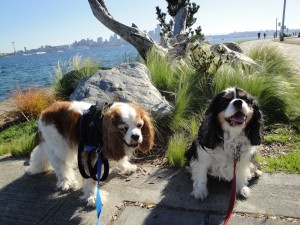 So here we are, at Part 4 of a four-part series on dying dogs and veterinarians. Like life, the series hasn’t been quite linear, so you can find the other parts in this diary here: Entry 6, #1, where we lose our long-time vet; Entry 8, #2, where we meet up again with a former vet; and Entry 10, #3, where we meet the radiologist.
So here we are, at Part 4 of a four-part series on dying dogs and veterinarians. Like life, the series hasn’t been quite linear, so you can find the other parts in this diary here: Entry 6, #1, where we lose our long-time vet; Entry 8, #2, where we meet up again with a former vet; and Entry 10, #3, where we meet the radiologist.
Today, we’re at diagnosis and solutions, with a consult with a veterinary surgeon.
The Vet and the Radiologist
I’d taken Murphy straight to Dr. Glenn Johnson at the West Seattle Animal Hospital on Monday, Dec. 26, 2011. I know most people wouldn’t have taken their dog in for coughing four times in the morning and at night, but I admit to being overprotective and proactive, and I’m proud of it (it is, however, expensive). Blood tests and a U/A revealed an infection, and we put her on antibiotics. On Wednesday, I was still convinced she needed an x-ray because I’m an intuitive, right, and I was convinced it was her heart (and I didn’t look any deeper than that, since we’d discovered a mild heart murmur in October).
Dr. Johnson humored me, partly, he admits, because of my stories of Cavaliers suddenly presenting with serious heart disease that started with a mild cough. But I was wrong: Murphy had a splenic tumor. A follow-up discussion with him and a look at an x-ray convinced me to order an ultrasound to be completely certain, so Murphy and I could figure out what to do.
I admit, I had lost my beloved English Cocker, Maggie, to a sudden illness and to exhaustion: mine. I had felt guilty for years about what I decided was a precipitated death: I believed I had given up on her without trying very hard to help, even though it was back in 1986 and veterinary care in the backwoods wasn’t anything like it is today. Still. I was determined to do right by Murphy.
We would figure it out step by step, I decided.
The radiologist made a special trip to the clinic to do Murphy’s ultrasound. He was determined to save her, convinced from the x-ray that it was cancer and determined to give her the best chance of surviving.
Except our dogs do not survive hemangiosarcoma. Ever.
I appreciated the irony. I had left the West Seattle Animal Hospital when Murphy was a young dog because of an issue over an ultrasound, and now we were back, and a radiologist and the clinic were turning Murphy’s care into a mission.
Awesome.
They were very clear. The radiologist, Lee Yannik, DVM, was sure she had a splenic tumor that was cancer, but everything else, including her heart, was fine. He wanted me to operate on her to give her the longest life possible. Dr. Johnson hesitated because of her age and underlying health issues: arthritis, bronchitis, her heart murmur, and the strong possibility it was cancer and couldn’t be cured. If she had surgery it had to be in a specialty clinic where she would be in intensive care 24/7.
It was clear I got some information, but not enough. I needed to talk with the people who saw these tumors all the time, so Dr. Johnson consulted with Jennifer Weh at ACCES in Seattle, and then I took Murphy to see her.
The Veterinary Surgeon
I had been to that clinic before, with a dear friend who lost her beloved dog to the same cancer they suggested Murphy had. What I noticed this time is that half their hospital, and half the reception area, was for cancer care. The waiting room was busy.
I quailed to see that. Would that be our future, waiting for cancer care?
Jennifer Weh DVM, was matter-of-fact, cordial, and, something I’ve seen a lot of in recent years: younger than me. I took an instant liking to her when she walked in the room and I explained that I wanted to explore Murphy’s options while understanding that as a surgeon she was predisposed to surgery.
“Now, don’t judge me,” she gently chided.
I liked that, gently reassuring me that she was not only capable of looking at the options but of also being open-minded. I figured we were going to get straight answers, whether I liked them or not.
And we did. She had discussed the case with Dr. Johnson and reviewed all the file notes from the radiologist. She also carefully examined Murphy, paying particular attention to the weakness in her hind legs that I had first noticed on occasion in early December.
Here’s the thing. They can’t ever be sure what they’re dealing with in these splenic tumors until they operate and take them out. Sometimes they look like cancer on x-ray and ultrasound, sometimes they look benign and only pathology on removed tumors reveals the cancer.
 Most of the time, Dr. Weh explained, the tumors abruptly bleed and the animals go into crisis, when they had appeared perfectly healthy the day before. It happens, but it isn’t as common to find it early like we did, before there were obvious signs of a problem, like a bleeding episode or swollen belly.
Most of the time, Dr. Weh explained, the tumors abruptly bleed and the animals go into crisis, when they had appeared perfectly healthy the day before. It happens, but it isn’t as common to find it early like we did, before there were obvious signs of a problem, like a bleeding episode or swollen belly.
Except we had a clear indication following blood tests on Dec. 26 that indicated anemia and an infection, and the x-ray on Dec. 28, which indicated the anemia could be from the tumor, which had bled and then sealed itself off.
It was possible it could be a benign tumor, meaning it was still on her spleen but it wasn’t cancer. In that case, not operating and removing was essentially a death sentence, because it would eventually rupture and Murphy would bleed out.
I asked about the possibility that her inherited blood disorder, a macroplatelet condition, had caused a problem with the spleen. It seemed logical: the spleen filters platelets, and since macroplatelets confuse it, what if the tumor was her body’s way of compensating for this condition? Then removing the tumor could kill her. An interesting theory, Dr. Weh said, but there were no studies, so no one knew. What they had been doing more recently, she said, was removing the spleens of these dogs. I have no idea when that therapy arrived, if I could have saved Murphy by removing her spleen as a young dog. I will investigate that at some point, so I can talk intelligently about it, but it was a moot issue for us: we had a spleen with a serious problem.
The Decision
What were we going to do about it?
Obviously we had to look at Murphy’s current condition. She had developed a heart arrhythmia, which occurs in dogs under distress, particularly old dogs with existing murmurs, and she had two murmurs: a mild mitral valve murmur, common to Cavaliers, and a moderate tricuspid valve murmur. She had arthritis, which was painful and slowing her down, although she was still pretty vibrant for her age. She had bronchitis, which was being treated.
Surgery would be complicated but not impossible, Dr. Weh assured me. They would compensate for the heart, and she would need to be in intensive care for several days. She would be down for a week or so, and probably not be able to do stairs for about 10 days. That was assuming everything went well. The actual removal of the spleen isn’t as hard as getting all the blood vessels properly tied off: that was a difficulty in older dogs.
It was daunting enough. I am handicapped, and we live one flight up in a condo. Getting Murphy up and down the stairs was hard enough with arthritis. It would be impossible with surgery: we would have to get help, but we could do it. But could I ask her to go through another surgery, to be uncomfortable and in pain from surgery, when I’d promised her I’d never ask her to do something like that again?
 And what about cost? The initial surgery and stay alone would be about $3000, barring complications. Frankly, I couldn’t afford it, I just couldn’t. But I’d find a way if I could help her, because that’s just what you did. Everything we’ve faced together as a family had been to beat something that we could beat, to give Murphy a healthy, happy life, to give her the chance to make her contribution to the family and to the world. To do the right thing.
And what about cost? The initial surgery and stay alone would be about $3000, barring complications. Frankly, I couldn’t afford it, I just couldn’t. But I’d find a way if I could help her, because that’s just what you did. Everything we’ve faced together as a family had been to beat something that we could beat, to give Murphy a healthy, happy life, to give her the chance to make her contribution to the family and to the world. To do the right thing.
What was the right thing? That’s what we were trying to find out. That’s why we went to see the surgeon, Dr. Weh, to the people who saw tumors like this every day, to understand what we could about what we faced.
Dr. Weh proved invaluable for that. She said people usually bring in their dogs who’ve presented in crisis, and the people are shocked, because they had been well, and they insisted on surgery to save them. To get more time to process the shock, to say goodbye, because it was usually cancer. In our case, we knew before a serious crisis presented itself.
The question was: if it was cancer, she was going to die anyway, because I’d already heard that you couldn’t beat it. The problem is: if it wasn’t cancer, simply a benign tumor, then Murphy would still die if I didn’t remove it, because it was still growing and would rupture and Murphy would bleed out.
What a hideous decision: unless I operated Murphy would die, but if it was cancer, she would die anyway, and with her age and underlying health issues, it wouldn’t be easy and might be impossible. The problem being: it might be impossible.
So what did Dr. Weh think it was?
Dr. Weh emphasized that the only way to know whether Murphy had cancer was to operate. Her best guess: she was more than 90 percent certain that it was cancer. The word ‘cavitated’ is very bad in medical terms, and a pretty good clue.
“This cancer is insidious,” she said. Even if you remove the tumor, it hides, and a single cell means doom. It’s aggressive and it’s fast. In fact, the early signs were on us in mid-December: the weakness in her hind legs was the tumor, she said, not the arthritis. I thought about that: the weakness I’d noticed, that I thought was different than her arthritis, actually was: it was the tumor.
We couldn’t beat the cancer. No one ever does. All you can do is buy time.
Murphy’s odds: six months with surgery and chemotherapy. Three months without.
I blinked back tears as I petted Murphy. I had wanted straight answers, and I got them.
I could operate on her, put her through surgery and the debilitation that comes with recovery and old age, complicated by arthritis and a weakening heart. Adding chemo to the mix, which could make her ill. All knowing that she was going to die anyway.
Or I could spend as much time with her as I could, keep her comfortable and happy. Keep the family happy.
I had a lot to think about. A lot to talk with Murphy about.
We had to make decisions on the bargains we’d made with each other: that we came together to get well, to heal, that we had done that, and that I had promised not to ask anything more of her.
Surgery was asking a lot. A lot to suffer through, for all of us, not just Murphy in recovery, and me being handicapped and in pain trying to carry her and care for her, but Alki and Grace the Cat suffering with us as our lives were disrupted.
I stood there and stared at this surgeon, this young woman, so matter-of-fact and so passionate about her work. So aware of the intimacy of the human-animal bond. So clear that what we were facing was a family decision, something for me and Murphy to decide together, and that her role as the veterinarian was to give her us the benefit of her knowledge and experience.
I was stunned and grief-stricken again, because I knew that either way I was most likely going to lose Murphy: she was spry for her age, but she was old for the breed, and she was starting to show it.
But another part of me was looking at this woman and wondering about what made her tick. What people choose to do with their lives is fascinating. How they live them. What they stand for. I admired her decency and integrity. Her smarts.
It was not the normal veterinary model: she was not playing the role of “I know best, you do what I say,” which is why we’d left our long-time vet. Here was a vet like Dr. Johnson and Dr. Yannik: people who cared, who were realistic, who knew their role was to relate their experience and opinion and let you choose your own course, even if, like Dr. Yannik, their choice was clear.
So I wondered what Dr. Weh thought, and decided to ask.
Biting back tears, I asked her, “So what do you call people who say ‘no’ to surgery?”
She stopped and looked me straight in the eye, a slight smile on her face.
In a soft voice she said: “Compassionate.”
© 2012 Robyn M Fritz



Dorie, thank you for your story! So glad you also had a good experience with Dr Weh. Thanks for sharing your stoy! My best to you and Dexter! Robyn